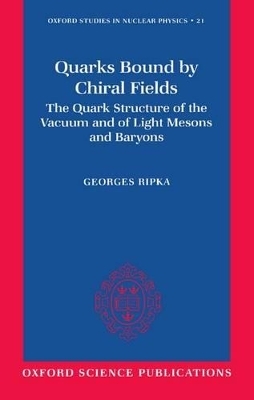
Quarks Bound by Chiral Fields
The Quark Structure of the Vacuum and of Light Mesons and Baryons
Seiten
1997
Oxford University Press (Verlag)
978-0-19-851784-9 (ISBN)
Oxford University Press (Verlag)
978-0-19-851784-9 (ISBN)
All elementary particles are made up of even more elementary constituents called quarks. Even the physical vacuum has a quark structure. This book is an introduction to the models used to describe the observed particles and the restoration of chiral symmetry at high temperatures and densities, and provides a useful overview of the modern techniques used in this area of particle physics.
The structure of light hadrons is dominated by the spontaneously broken chiral symmetry of the strongly interacting (QCD) vacuum. Low energy properties of light hadrons can be described in terms of quarks interacting with chiral fields. This book gives a comprehensive account of a large class of models which describe the restoration of chiral symmetry at high temperature and density, the effective interactions between quarks, mesons as solutions of the Beth-Salpeter equation, and baryons in terms of solitons which rotate in flavor space. An in-depth analysis of regularization is given, including regularization by delocalized fields. Symmetry conserving approximations are formulated using both path integral and Feynmann graph methods. The style is pedagogical and well suited to graduate and PhD students who want to learn the techniques used in present day research. It can also serve as a reference for research and lecture courses.
The structure of light hadrons is dominated by the spontaneously broken chiral symmetry of the strongly interacting (QCD) vacuum. Low energy properties of light hadrons can be described in terms of quarks interacting with chiral fields. This book gives a comprehensive account of a large class of models which describe the restoration of chiral symmetry at high temperature and density, the effective interactions between quarks, mesons as solutions of the Beth-Salpeter equation, and baryons in terms of solitons which rotate in flavor space. An in-depth analysis of regularization is given, including regularization by delocalized fields. Symmetry conserving approximations are formulated using both path integral and Feynmann graph methods. The style is pedagogical and well suited to graduate and PhD students who want to learn the techniques used in present day research. It can also serve as a reference for research and lecture courses.
Introduction ; 1. Quark bilinear operators ; 2. Effective quark interactions ; 3. The NambuJona-Lasinio model ; 4. The equivalent linear sigma model ; 5. Regularization ; 6. Correlation functions: basic properties ; 7. Symmetry conserving approximations ; 8. Correlation functions in the NambuJona-Lasinio model ; 9. Overview of results in the meson sector ; 10. Further chiral quark models ; 11. Chiral Solitons ; 12. Rotations of solitons in flavor space ; A. SU(N) matrices, Dirac matrices, Fierz transformations ; B. The SU(N) rotor ; C. Bosonization ; References
| Erscheint lt. Verlag | 5.6.1997 |
|---|---|
| Reihe/Serie | Oxford Studies in Nuclear Physics ; 21 |
| Zusatzinfo | line figures, tables |
| Verlagsort | Oxford |
| Sprache | englisch |
| Maße | 161 x 242 mm |
| Gewicht | 462 g |
| Themenwelt | Naturwissenschaften ► Physik / Astronomie ► Atom- / Kern- / Molekularphysik |
| Naturwissenschaften ► Physik / Astronomie ► Hochenergiephysik / Teilchenphysik | |
| Naturwissenschaften ► Physik / Astronomie ► Quantenphysik | |
| ISBN-10 | 0-19-851784-X / 019851784X |
| ISBN-13 | 978-0-19-851784-9 / 9780198517849 |
| Zustand | Neuware |
| Haben Sie eine Frage zum Produkt? |
Mehr entdecken
aus dem Bereich
aus dem Bereich
Buch | Softcover (2024)
Wiley-VCH (Verlag)
CHF 83,85


